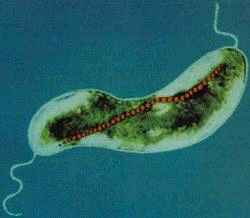Date : 7/10/14
Topic : Internal structures of bacteria (inclusions)
Activities
1. Quiz by using socrative
Notes
Name of microbes
Azotobacter is a genus of oval or spherical bacteria. They are motile and can form thick-walled cysts and may produce large quantities of capsular slime as well.They are aerobic, free-living soil microbes and can fix nitrogen into ammonium. It is used to produce biofertilizers, food additives and some biopolymers.
(E.g. Azotobacter vinelandii)
Halothiobacillus neapolitanus is a genus of proteobacteria, also classified with purple sulfur bacteria. All species are obligate aerobic bacteria. They have carboxysomes.
Aquaspirillum magnetotacticum is one of the four magnetotactic bacterium under gram-negative, microaerophillic (grow in low concentrations of oxygen) genus of magnetospirillum. They are spirillar or helical and have polar flagellum at each end. They live in shallow fresh water and sediments. They are magnetotaxis, meaning can orient themselves according to Earth's magnetic field and are aerotaxis, meaning will remain themselves in favourable oxygen concentration. When the bacteria ingest iron, proteins inside their bodies interact with iron to produce magnetite, Fe3O4.

Proteobacteria are major group of Gram-negative bacteria that includes purple bacteria, pathogens, free-living (non-parasitic) and nitrogen-fixing bacteria. Some have flagella, some are nonmotile or rely on bacterial gliding and some can aggregate to form multicellular fruiting bodies. Some are facultatively or obligately anaerobic, chemoautotrophs, and heterotrophic.
E.g. Escherichia, Salmonella, Vibrio, Helicobacter, Yersinia
Neocallimastix (-mastix = whips = many flagella) is a genus of obligately anaerobic rumen fungi. Besides fungi, microbial population of rumen also consists of bacteria and protozoan. They are lack of mitochondira, instead they use hydrogenosomes to oxideze NADH to NAD+ and release H2 as product. They can produce polysaccharide degrading enzymes to help in digestion of fibres.
Clostridium tetani is a box-car shaped, anaerobic Clostridium bacterium. They are Gram-positive and found as spores in soil or in gastrointestinal tract of animals. They produce tetanospasmin (potent biological toxin) that causes tetanus.
Clostridium perfringens is a Gram-positive, rod-shaped, anaerobic, spore-forming Clostridium bacterium. They can be found in nature as normal component of decaying vegetation, marine sediment, animals (especially in the intestinal tracts), insects and soil. They can cause food poisoning and infection such as necrosis, bacteremia (presence of bacteria in blood = abnomal because blood is sterile), emphysematous cholecystitis (infection of gallbladder) and gas gangrene.
Terms in microbiology
Volutin granules are an intracytoplasmic storage form of complexed inorganic polyphosphate.
Random facts
- Microbial nutrition can be deduced from two factors, which are source of carbon and source of energy.
- if source of carbon is CO2, and source of energy is light, then it is a photosynthetic microbe
- if source of carbon is organic molecules, then it is a heterotroph
- Hydrogen peroxide is also an ingredient in hair dye. Some microbes can avoid accumulation of hydrogen peroxide by having magnetosomes to avoid it. Some can neutralise the toxicit of hydrogen peroxide by secreting enzyme peroxidase.
- Gas vacuoles are normally found in protozoa and eukaryotes. Gas vesicles are normally forund in bacteria.
- There are many types of sulfur bacteria : purple sulfur, green sulfur, non sulfur
- There are many classes of proteobacteria : Alpha/Beta/Gamma/Delta/Epsilonproteobacteria
- Endospores are very tough and resistant to harm. They can only be destroyed by using certain radiation.
- Dipicolinic acid that is found in core wall of endospores is important to protect DNA against damage due to wet and dry heat, desiccation and genotoxic chemical.
- Current topics in microbiology can be found in sciencedaily.com and microbial world.
- Gas in gas gangrene is found to has the same composition as with atmospheric air.
-
My own exploration
- Teeming life in a drop of water
- Foldscope
- Nanoscope
- http://www.microscopyu.com/moviegallery/pondscum/metopus/
- http://en.wikipedia.org/wiki/Necrotizing_fasciitis
- http://www.sciencelearn.org.nz/Contexts/Exploring-with-Microscopes/Sci-Media/Interactives/Which-microscope
- http://en.wikipedia.org/wiki/HeLa
- http://www.youtube.com/watch?v=8SuJxsQRnfw
- http://www.youtube.com/watch?v=dRNYWX4v0VE
- https://www.google.com.my/url?sa=t&rct=j&q=&esrc=s&source=web&cd=7&ved=0CD4QFjAG&url=http%3A%2F%2Fio9.com%2F5908318%2F10-surprising-things-that-bacteria-like-to-eat&ei=J0M2VOHOGtO7uASbjoDYDQ&usg=AFQjCNHJpCRpNl5pfnKge215KRGP5eGp0Q&sig2=Dn5z97qoeA5R32Af6t6Xtw&bvm=bv.76943099,d.c2E&cad=rja
It's basically learning new information and there was no much reflection done in this topic. However, realizing that bacteria such as Clostridium bacteria can cause severe infection like gangrene and necrosis did terrify me. It made me realize the importance of good hygiene because indeed, prevention is better than cure.

No comments:
Post a Comment